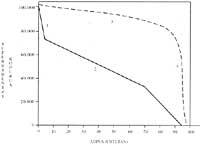Aging
As we all know, aging is natural both in our species (Homo Sapiens) and in other pluricellular species. In societies developed so far, old age has been considered totally different. Today's human old age has become a serious social problem. Also, in societies old age was not considered a problem.

On the contrary, it was appreciated because in these societies most people died before reaching old age. Advances in medicine and social advances have made the population considerably more likely to live. Our society considers aging as a disease, but the latest research is showing that aging can be a natural process in all animals.
Animal cells have been isolated (fibroblasts, liver cells, etc.) and if placed in appropriate conditions they reproduce by mitosis, giving rise to cell cultures. These repetitions do not occur without limits, but in a limited way. Embryonic fibroblasts, for example, are as much as less than fifty, losing the ability of cell repetition behind them. All this indicates that aging also appears at the cellular level.
Existing unicellular organisms at the beginning of evolution repeated themselves without limits. Currently there are such cells (bacteria, etc. ). Specialization in multi-cellular organisms also resulted in aging. These organisms contain specialized cells. All other cells differentiated from pluricellular organisms have lost that initial indefinite repetition of evolution, as it is not necessary for the species. Conversely, cancer cells have lost this aging process.
In the process of specialization in evolution, the more specialized the cell, the smaller the number of repetitions. A representative example within the human being is the neuron.
Neurons are very special in many ways:
- In adult humans neurons have no repetition capacity.
- The metabolism of neurons is based exclusively on glucose and are extremely delicate.
- Neurons have a single function: transporting electric pulses.

As in the first years of human life neurons lose their ability to repeat, with the neurons that have in those moments the person will have to spend his whole life. Throughout life neurons are progressively lost and in old age the effects of this process will be more noticeable. Due to the importance of the function of the neuron and the total loss of repeatability, the aging process occurs first in the brain.
The aging process in other tissues will not occur so quickly, as the repeatability is not completely lost and the cells degenerated by repetition can be renewed. Before other types of cells, epithelial cells, blood cells, and intestinal epithelium cells lose their replicating ability, man dies.
But how do cells age? What intracellular processes are affected?
To answer all these questions, many different theories have been published in recent years. These theories include so-called “free radicals” and “catastrophic errors.” The first is related to the processes that take place in the mitochondria. Mitochondria produce as ATP the useful energy that the cell needs. Free radicals are created in this process. These imbalance over time the most important aspects of the mitochondria. As a result, the energy needed to cover the physiological processes of the cell is not obtained.
The theory of catastrophic error states that as the age of beings progresses, errors in the mechanisms of transfer of genetic information accumulate. Therefore, catastrophic errors will also appear in protein synthesis. Today we know that most of the human DNA sequence is repetitive. These sequences do not intervene in protein synthesis. So what function do these repetitive sequences have?
The theory we use to explain its function says it can exercise a protective function against DNA attacks. Examples of the latter would be ultraviolet rays and some toxic harmful products.
As we age, a series of events happen that we all know: grandparents immediately forget the new information, do not remember the new names, are lost in the usual places where they have been. Within this process, after memory loss other events can occur: they lose social inhibitions, suffer mood changes, sleep less and less, the performance of the mind is reduced and finally plunge into depression.
Along with this, our displacement capacity is often reduced (acinesia). They often vibrate. These last two processes are two symptoms of Parkinson's disease. The dysfunctions mentioned above are changes in the superior functions of the brain. We normally know them as dementia and the most important thing would be Alzheimer's disease. In these diseases tissue alterations have been detected in certain areas of the brain. Parkinson's disease is based on degenerative dysfunctions of the basal ganglia of the brain. In Alzehimer's disease there are also degenerative dysfunctions in different parts of the brain: hippocampus, tonsils, etc. Although Alzheimer's and Parkinson's are two different diseases, in old age they can appear at the same time.
After the histological study of the brains in these diseases, signs of degeneration have been observed. There are elderly people who do not have these degenerative diseases, but this does not mean that the brains of these old histologically studied do not show signs of degeneration. The degeneration of these latter cases does not reach the degree of degeneration in Parkinson and Alzheimer, but they are usually degenerations of the same type.
So Alzheimer's and Parkinson's are they a disease or a natural process? Why are there symptoms in some people and not others? How long does it take for symptoms of neuronal aging to appear?

Some authors consider these degenerative diseases to be due to a toxic process. Intoxication takes place and appears in old age. These toxic substances are unknown, whether they are external or internal substances. These toxicological theories linked to “in vivo” aging are easily related to the theory of free radicals, developed through experiments carried out in the aforementioned cell cultures. Researchers are working on whether this relationship exists or not. There are many things to investigate about aging, both in vitro and in vivo.
Theories that can be presented in the future can be a compilation of all of them. We would need more advanced techniques than current ones to solve the intracellular processes that occur in old age.
By not repeating the neuron, for its special properties in general, and also for having special brain diseases, it would be more interesting to investigate the aging process in neurons than in other cells.





